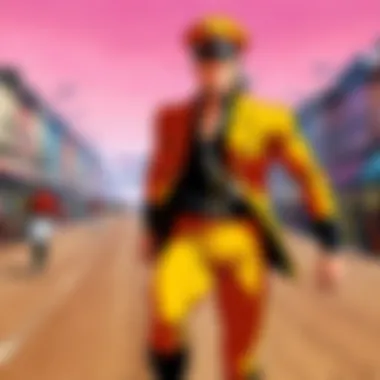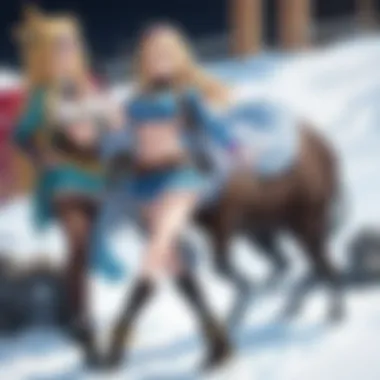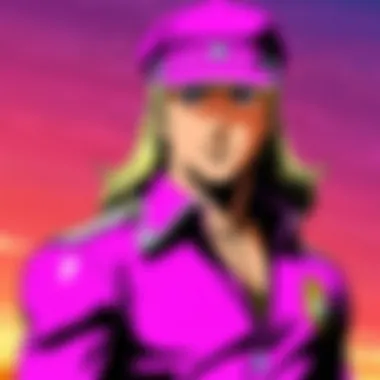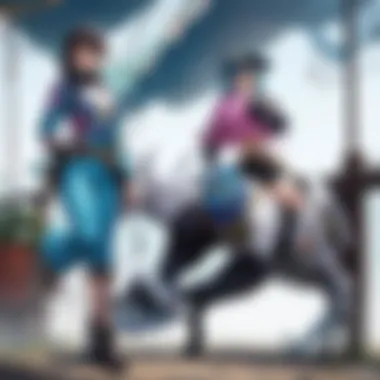Exploring JoJo's Steel Ball Run: A Comprehensive Analysis


Intro
JoJo's Steel Ball Run represents a critical juncture within the larger tapestry of JoJo's Bizarre Adventure. It transcends a mere continuation of Hirohiko Araki's celebrated series, emerging as a stand-alone narrative that exploration rich character arcs and intricate thematic elements. This analysis endeavors to illuminate the fundamental aspects that elevate Steel Ball Run to its esteemed status. From examining the character profiles to delving into thematic explorations, this article offers a comprehensive understanding of this pivotal manga installment.
Character Profiles
Overview of Main Characters
The narrative unfolds with Johnny Joestar, a complex protagonist whose journey is marked by both physical and emotional turmoil. A former jockey, Johnny loses the ability to walk due to an accident. His struggle to find purpose in a body diminished by tragedy underscores his development throughout the story.
The other vital figure is Gyro Zeppeli, a mysterious and skilled fighter. Gyro serves not only as a mentor to Johnny but also embodies the philosophy of the Steel Ball Run race. His captivating persona, combined with his unique approach to combat and life, enriches the narrative.
Supporting Characters
Supporting characters significantly contribute to the progression of Steel Ball Run. Notable figures include:
- Funny Valentine: The enigmatic president of the United States whose ambition sets the stage for the competition.
- Hot Pants: A competitor with a hidden agenda and a critical role in the overarching plot.
- Pocoloco: An underdog who provides comic relief yet embodies the struggle against adversity.
These complex relationships and interactions among characters deepen the narrative, adding layers to the central themes.
Theme Exploration
Central Themes
Steel Ball Run explores multiple themes, including determination, identity, and morality. The transformation of Johnny Joestar symbolizes the quest for identity, especially as he grapples with his past. His journey reflects the broader human struggle to overcome internal and external challenges.
Another pivotal theme is the nature of ambition as illustrated by Gyro and Funny Valentine. Their contrasting motivations emphasize the moral complexities of ambition within the narrative.
Cultural References
Cultural elements manifest intricately throughout the work. Araki integrates Western motifs, particularly through the setting of early 20th-century America and the concept of a race embedded with cultural significance. This setting serves as a canvas for commentary on ambition, freedom, and the human experience.
"JoJo's Steel Ball Run reinvigorates the narrative structure of manga, weaving together diverse themes and rich characters to create a unique experience."
Finale
Steel Ball Run stands as a monumental achievement not just for Araki but for manga as a medium. By emphasizing the character development and thematic depth, it invites readers to engage on multiple levels. Indeed, it enriches the understanding of JoJo's Bizarre Adventure, ensuring its legacy endures. Readers seeking insight into characters, themes, and the cultural implications of the series will find this exploration invaluable.
Intro to Steel Ball Run
The introduction of Steel Ball Run marks a vital point in the overarching narrative of JoJo's Bizarre Adventure. As the seventh part of this renowned series, it stands apart not merely as a continuation, but as a transformative chapter that adapts and evolves the foundational themes of its predecessors. Steel Ball Run takes place in a different world compared to earlier parts, presenting itself not only as a fresh story but also as a commentary on the past. This section seeks to establish the significance of this installment by discussing its context and release.
Historical Context of JoJo's Bizarre Adventure
JoJo's Bizarre Adventure, created by Hirohiko Araki, began its journey in 1987. Over the decades, it amassed a dedicated following drawn to its peculiar blend of action, supernatural elements, and intricate storytelling. Past arcs explored themes of battles, legacy, and the complexities of familial relationships. Each part has its unique aesthetic and philosophical undertones. Steel Ball Run emerges from this rich tapestry, changing not only setting but also reshaping the narrative itself.
The historical context comes into play with shifts in Japanese manga trends. By the time Steel Ball Run debuted, the industry had seen increased diversification in storytelling methods and character developments. Fans craved more than straightforward heroism; they desired complex narratives that reflected deeper societal themes. The timing in the mangaka's career and cultural backdrop serves to highlight the relevance of Steel Ball Run in both the JoJo franchise and the wider manga scene.
Overview of Steel Ball Run's Release
Steel Ball Run was serialized in Weekly Shōnen Jump from 2004 to 2011. Initially met with both curiosity and skepticism, this installment redefined what many fans expected from the series. The manga was released after a short hiatus in which Araki reflected on his previous works and the evolution of his style.


The reception throughout its run varied. While some longtime followers embraced the changes, others were unsure about the new direction. Over time, however, Steel Ball Run gained acclaim for its ambitious plotting and character complexity.
The transition from Weekly Shōnen Jump to a standalone volume format marked a significant shift in how the story was presented. This allowed Araki greater freedom to experiment with pacing, character depth, and thematic exploration, absent from ongoing weekly installments.
Overall, the release of Steel Ball Run is not just a continuation of JoJo's Bizarre Adventure but signifies a noteworthy point in its maturation as a series.
Narrative Structure
Understanding the narrative structure of Steel Ball Run is essential for appreciating its complexity and depth. The well-crafted structure provides a framework that shapes the story and influences character development, pacing, and thematic exploration. In this section, we break down the key components of the narrative that contribute to the overall success of the series.
Plot Synopsis
Steel Ball Run is set in the United States during the late 19th century, following a cross-country race from San Diego to New York. The main protagonist, Johnny Joestar, is a paraplegic former jockey seeking redemption. His journey intertwines with Gyro Zeppeli, a mysterious figure with expert skills in the use of "Steel Balls." The race becomes a backdrop for various battles against other racers, each possessing unique abilities tied to the mysterious concept of "Stand" powers. The narrative escalates through encounters with antagonists who challenge both Johnny and Gyro, testing their resolve and philosophies. The plot weaves personal challenges with the larger quest, creating a multi-layered experience that goes beyond simple competition.
Character Arcs
The character arcs in Steel Ball Run are profound and engaging. Johnny's journey transforms from one of desperation to self-discovery. Initially burdened by his past and physical limitations, he gradually learns to embrace his identity and strengths. Gyro, on the other hand, embodies the duality of mentor and enigma. His motivations remain shrouded in mystery as the narrative unfolds, prompting readers to invest in his character. The interplay between these two characters is crucial. Their evolving relationship encapsulates themes of trust, rivalry, and the quest for meaning in their lives.
Pacing and Storytelling Techniques
The pacing of Steel Ball Run is deliberate, allowing for both action and character development to coexist harmoniously. For example, intense race scenes alternate with slower, contemplative moments, allowing readers to digest critical themes and plots. Araki's storytelling techniques include flashbacks that provide insight into characters' motivations, while cliffhangers at the end of chapters maintain engagement. This balance ensures that readers are not overwhelmed by action but remain invested in the characters’ journeys. Moreover, the transitions between action and reflection effectively reinforce the narrative’s emotional weight.
"The narrative structure is not just a delivery method; it defines how deeply the audience connects with the characters and themes."
Through these elements, Steel Ball Run establishes a rich narrative that goes beyond mere entertainment, inviting analysis of its themes and character developments. The confluence of plot, character arcs, and pacing creates a comprehensive framework that enhances the reading experience.
Character Analysis
Character analysis is crucial in understanding the deeper layers of Steel Ball Run. The characters are not mere vessels for the plot; they embody the themes and conflicts that arise throughout the story. Each character brings unique traits and motivations, enriching the narrative while also reflecting broader human experiences. A thorough examination of these figures allows us to see how they contribute to the complex world Hirohiko Araki has created. It also emphasizes the dynamic interactions among characters, revealing the nuances that drive the storyline forward.
Main Protagonists
The main protagonists in Steel Ball Run are Johnny Joestar and Gyro Zeppeli. Johnny is a once-famous jockey struggling with his paralysis, and Gyro is a skilled baseball player who uses his techniques to participate in the race. Their initial meeting sparks a pivotal partnership that evolves over the course of the series.
Johnny's journey represents more than a quest for physical healing; it signifies a deeper search for identity and self-worth. He goes from a reluctant participant to a determined individual, showcasing resilience in a life filled with challenges.
Gyro Zeppeli, on the other hand, embodies the spirit of mentorship. His philosophical views on life and power profoundly influence Johnny. The duality of their characters highlights the themes of friendship and rivalry that pervade the series.
Antagonists and Their Motivations
Antagonists in Steel Ball Run present rich complexities. The primary antagonist, Funny Valentine, seeks to fulfill his vision of what America should be. His motivations stem from a blend of patriotism and personal ambition, making him a compelling villain. Unlike typical antagonists driven solely by malice, Funny's goals are deeply tied to his idea of a "greater good," which poses moral questions about the lengths one will go to achieve their vision.
Additionally, other adversaries test Johnny and Gyro throughout their journey. Each antagonist has distinct motivations, whether it’s revenge, ambition, or personal philosophy. Understanding these motivations adds depth to the conflict, making it resonate on multiple levels.
Supporting Characters and Their Roles
Supporting characters in Steel Ball Run play significant roles in enhancing the main protagonists' journeys. Characters such as Mountain Tim and Hot Pants contribute to the rich narrative tapestry and provide additional layers of context and conflict.
- Mountain Tim: Represents loyalty and loss, showcasing the personal costs of ambition as he grapples with his past decisions.
- Hot Pants: Her complex relationship with Gyro introduces themes of trust and betrayal, highlighting that not all support is built on solid ground.
These supporting figures illuminate different aspects of the story, providing insight into the protagonists’ growth. They serve as mirrors, reflecting the challenges and growth of Johnny and Gyro.


Character dynamics in Steel Ball Run create a compelling narrative tapestry that resonates with readers. Each figure, from protagonists to antagonists and supporting characters, enriches the discourse on themes such as identity, ambition, and the human condition. \
"In-depth character exploration is as important as the narrative itself; it reveals the heart of the story."
By delving into character analyses, we better grasp the intricate layers that define Steel Ball Run, making it a vital component of the overall examination.
Thematic Elements
The thematic elements in JoJo's Steel Ball Run are crucial for understanding the depth and complexity of the narrative. The themes explored in this manga are interwoven into the character arcs and plot progression, making them vital to the overall understanding of the story. Not only do these elements resonate with the audience on a personal level, but they also reflect broader human experiences and moral dilemmas that are relatable across cultures.
Friendship and Rivalry
Friendship and rivalry are central motifs in Steel Ball Run. The narrative presents a variety of relationships that embody both competition and camaraderie. The unique bond between Johnny Joestar and Gyro Zeppeli exemplifies this theme. Their initial interactions reveal tension and distrust, stemming from their different motivations in the race. As the story progresses, their relationship morphs into one of deep respect and mutual support.
This evolution highlights the notion that rivalry can often foster growth and profound connections. Ultimately, it demonstrates that the drive to surpass one another can be a catalyst for personal transformation and a deeper understanding of oneself. The complexity of these relationships invites readers to reflect on their own lives, contemplating the balance between competition and support in their interactions.
The Pursuit of Power
The pursuit of power is another crucial theme within Steel Ball Run. Characters are often faced with moral choices that lead them to seek power for various reasons. For some, it is about dominance and control, while for others, power serves as a means of self-discovery and redemption. The race itself becomes a metaphor for this pursuit, representing the lengths individuals will go to achieve their goals.
The character of Funny Valentine illustrates this theme effectively. As a key antagonist, he embodies the darker aspects of power, showing how ambition can lead to manipulation and betrayal. His actions create a tension that invites readers to question the morality of power-seeking. Are the consequences of one's ambition worth the cost? This theme resonates strongly, encouraging the audience to think critically about the implications of their desires for power and influence.
Identity and Transformation
Identity and transformation are recurrent themes that play a significant role in character development throughout Steel Ball Run. Many protagonists experience a journey of self-discovery, often influenced by their surroundings and the events unfolding around them. Johnny Joestar's evolution is particularly notable as he grapples with his disability and finds meaning in his participation in the race.
As the story unfolds, he transforms from a passive individual into an empowered character who takes agency over his life. This transformation underscores the idea that identity is not static. Each character’s journey invites the reader to reflect on the nature of change in their own lives.
Artistic Style
The artistic style of Steel Ball Run holds paramount significance in shaping the overall experience and understanding of the narrative. Hirohiko Araki's approach to illustration serves not only as a visual guide but also enhances the thematic and emotional depth of the story. The interplay between character design, illustration techniques, and symbolic representation creates a dynamic environment that draws the reader into the world of Steel Ball Run.
Readers often overlook the importance of artistic choices in narrative construction. The artwork becomes a language in itself, conveying emotions and amplifying stakes without explicit dialogue. As a result, a deeper analysis of Steel Ball Run’s artistic style reveals layers of meaning and insight into the characters' journeys and the themes explored throughout the series.
Illustration Techniques
In Steel Ball Run, distinct illustration techniques contribute to the telling of the story. Araki frequently employs varying line weights to emphasize movement and emotion. The use of sharp, bold lines indicates moments of tension or conflict, while softer lines can depict calm or reflection. This shift in visual tone aids in guiding the reader’s emotional response.
Furthermore, Araki has effectively used perspective and framing to create dynamic action sequences. The angles from which scenes are depicted often convey speed and intensity, reflective of the race that lies at the center of the plot.
- Action Panels: Often feature exaggerated poses to highlight the impact of clashes between characters, emphasizing the series' thematic undercurrents of struggle and ambition.
- Close-Ups: Focus on characters' faces reveal subtle emotional cues, deepening the reader's engagement with the story.
These techniques not only serve aesthetic purposes but also enhance the storytelling, allowing readers to feel the weight of each moment as it unfolds.
Character Design Evolution
Character design in Steel Ball Run represents a noteworthy evolution from previous installments of the JoJo's Bizarre Adventure series. Araki’s designs exhibit a refinement that reflects both maturation in artistic technique and an understanding of character individuality.
Each character is visually distinctive, infused with details that narrate their personality or motivations. For instance, Johnny Joestar’s progression from a frail figure to a more imposing presence is mirrored in his design changes throughout the series. This evolution is significant for character development, allowing readers to visualize growth and transformation.
- Fashion Trends: Araki incorporates contemporary fashion into character wardrobes, rooting each character in a recognizable context while distinguishing their personal styles.
- Physical Attributes: Alterations in hairstyle, body structure, and clothing can reflect changes in a character's arc, reinforcing themes of identity and transformation.


Through character design, Araki creates an immediate connection to his characters' journeys, making them relatable and memorable.
Symbolism in Art
Symbolism occupies a crucial role in the artistic narrative of Steel Ball Run. Each illustration is often rich with visual metaphors aimed at conveying deeper meanings. For example, the recurring motif of the spiral symbolizes the journey of life and the complexity of the characters’ experiences. This is evident in various scenes where spirals appear in the background or as part of character motifs.
Other symbols are more character-specific. For instance, the contrasting colors used for different factions highlight thematic divides and allegiances within the story. The visual representation of stands aligns closely with their abilities and personalities, providing insight without the need for extensive explanation.
"In the world of Steel Ball Run, every image carries the weight of potential meaning, connecting the viewer not just to the story but to the underlying philosophies embedded within them."
To summarize, the artistic style in Steel Ball Run is not merely decorative. It plays an essential role in character development, emotional engagement, and thematic exploration, providing a fuller understanding of what makes this installment of the JoJo’s Bizarre Adventure series remarkable.
Cultural Impact and Reception
The cultural impact of Steel Ball Run is significant, not only within the JoJo's Bizarre Adventure series but also in the wider context of manga and anime. This installment marks a transition in storytelling, themes, and artistic expression. By exploring its reception and the vibrant fan community, we can understand how Steel Ball Run has shaped contemporary culture and continues to influence new generations of creators and audiences alike.
Fan Community Engagement
The dedication of the fan community surrounding Steel Ball Run is a testament to its depth. Fans engage in discussions through social media platforms like Reddit and Facebook, creating environments where theories and interpretations flourish. Through cosplay and fan art, the characters resonate on personal levels, influencing various art styles and showcasing individual creativity. Forums are filled with detailed analyses, highlighting character motivations and plot intricacies.
One prominent aspect is fan fiction, which expands upon the narratives and gives new perspectives to existing characters. This creative engagement allows fans to explore themes of rivalry and friendship beyond the manga's original scope. Additionally, fan events and gatherings often celebrate anniversaries or milestones related to Steel Ball Run. This active participation strengthens the community and enhances the experience of following the series.
Critical Reception
Critically, Steel Ball Run has been heralded for its bold narrative choices and character development. Reviewers have pointed to the series' unique approach to storytelling, often noting its willingness to tackle complex themes such as identity and morality. Critics highlight how Hirohiko Araki evolves traditional manga tropes, incorporating American history and culture into a Japanese narrative framework, which surprised many.
Positive reviews frequently mention the quality of artistic innovation in Steel Ball Run. The artwork represents a significant evolution that both new and long-time fans appreciate. The series won multiple awards, solidifying its status as a major work in manga. Overall, critics have contributed to its legacy by drawing attention to its artistry and complex characters, paving the way for a deeper discussion surrounding its themes and motifs.
Global Influence and Adaptations
Steel Ball Run has seen global adaptations and influences that speak to its broader appeal. The manga's themes resonate not just in Japan but also in international markets. The setting during the 19th century American context allows it to touch on universal themes, making it relatable to audiences worldwide.
Adaptations in various formats, including video games and merchandise, have further propelled its influence. Fans of the series will find aspects of Steel Ball Run reflected in modern pop culture and related media. For instance, the distinct Stand abilities inspire design and character-building in video games that celebrate similar themes of power and identity.
In summary, the cultural impact of Steel Ball Run is multi-faceted. It engages a devoted fan base, garners critical acclaim, and influences a variety of global adaptations and media. As we delve deeper into the nuances of this installment, understanding its place in both the JoJo's Bizarre Adventure series and the larger landscape of manga becomes essential.
Epilogue
The conclusion of this analysis focuses on the significance of Steel Ball Run within the broader context of the JoJo's Bizarre Adventure series. This section synthesizes the key insights derived from the previous sections, emphasizing the rich narrative structure, complex character development, and thematic depth.
Steel Ball Run serves not only as a pivotal point in the JoJo universe but also as a reflection of societal themes that resonate with its audience. By analyzing the interactions between characters, the versatility in storytelling, and the artistic innovations introduced by Hirohiko Araki, we uncover the layers that make this manga exceptional.
Summary of Key Insights
The analysis has revealed several essential points about Steel Ball Run:
- Narrative Complexity: The plot interweaves multiple perspectives, enhancing the storytelling experience. Each character's journey contributes to a larger narrative tapestry.
- Character Depth: Protagonists like Johnny Joestar and Gyro Zeppeli evolve significantly, embodying themes of growth and transformation. The nuanced antagonists also deepen the conflict, providing a multifaceted view of motives and desires.
- Thematic Resonance: Friendship, rivalry, and the quest for identity emerge as central themes. These elements create a narrative that resonates with readers on an emotional level.
- Artistic Evolution: The artwork has evolved, showcasing distinct styles that parallel character development and thematic richness. Araki's artistic choices reflect the complexities of the story.
Overall, these insights highlight Steel Ball Run as a landmark work within the manga genre and contribute to its enduring popularity among fans and scholars alike.
Future of JoJo's Bizarre Adventure
Looking ahead, the future of the JoJo's Bizarre Adventure series remains intriguing. With the completion of Steel Ball Run, there are avenues for expanding its universe.
- New Story Arcs: Possible new storylines may explore fresh themes or return to classic elements. Fans might anticipate new characters that engage with existing legends.
- Legacy and Cultural Significance: The impact of Steel Ball Run on manga as a medium opens discussions on its influence in storytelling techniques and character representation.
- Adaptations: Further adaptations, be it in anime or live-action formats, are likely to enhance its accessibility to new audiences. The evolving landscape of media could provide innovative approaches to presenting the material.
In summary, the JoJo's Bizarre Adventure series has a robust legacy, and Steel Ball Run contributes significantly to this ongoing narrative. Its themes and characters invite continuous exploration and discussion, ensuring its place in both contemporary and future contexts.







